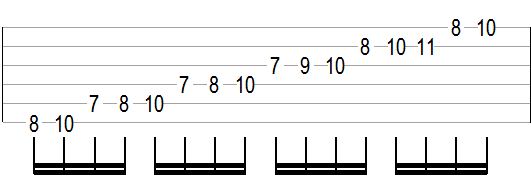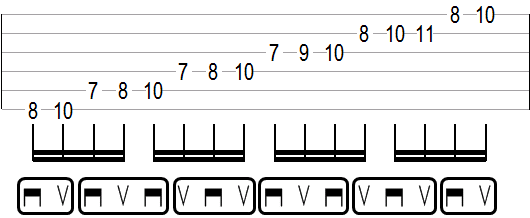7 Ways The CAGED System Hurts Your Guitar Playing
By Tom Hess
IMPROVE YOUR GUITAR SPEED
BY AT LEAST 100%
ENTER YOUR NAME AND
EMAIL TO GET ACCESS
FREE E-GUIDE
By submitting your info, you agree to send it to Tom Hess Music Corporation who will process and use it according to their privacy policy.
The CAGED guitar scales system is one of the most damaging things a guitar student can learn. Here are some of the major problems that CAGED typically causes:
Problem #1: The CAGED system makes it harder to develop your guitar speed… and makes it impossible to reach your maximum speed potential.
CAGED scale patterns contain a mix of 2-notes-per-string and 3-notes-per-string fragments. This inconsistent pattern causes several interconnected problems:
- Picking motions are inconsistent as you move from string to string. This inconsistency requires more muscle memory training to play guitar accurately at fast speeds.
“But Tom, how are the picking motions inconsistent when using alternate picking, isn’t the pattern simply down-up- down-up, etc.?”
It’s not as simple as that. Here’s why: Take a look at an example of CAGED scale patterns:

As you can see, when alternate picking is used, every single string has a different picking pattern than the one before it and after it:
String 6 = Down-Up
String 5 = Down-Up- Down
String 4 = Up-Down- Up
String 3 = Down-Up- Down
String 2 = Up-Down- Up
String 1 = Down-Up
To make things worse, all 5 CAGED scale shapes have completely different picking patterns from each other. Yes, that’s right: your picking hand needs to learn a different, inconsistent and inefficient picking pattern for each scale shape. Not only is this harder to play physically, but it also takes longer to train your picking hand muscle memory. This limits your speed both on a physical and mental level.
- The alternate picking pattern naturally embedded within the CAGED scales is very inefficient.
CAGED scale pattern using Alternate Picking:

These inefficiencies force your picking hand to move much more than necessary. That slows your picking speed down, making it much harder to play fast and accurately. CAGED makes reaching your maximum guitar speed potential impossible because the picking patterns required to play CAGED scales will never allow you to pick at your top potential speed. The 3-Notes-Per-String scale system not only allows you to actually reach your top speed potential, but you will improve your guitar speed at a much faster rate.
There is a much better way to learn, play and master scales: The 3-Notes-Per-String Scale System
All the inconsistency and inefficiency problems of the CAGED system are totally eliminated in the 3-Notes-Per-String system. Notice the perfectly consistent & efficient picking pattern and movements below.
3 Notes-Per-String scale pattern using Directional Picking:

Each string’s picking pattern is consistent. More importantly, your picking hand is now set up to move in the most efficient way possible.
Perfect picking efficiency means you play much faster, cleaner and easier than you ever could with any other scale system.
IMPROVE YOUR GUITAR SPEED
BY AT LEAST 100%
ENTER YOUR NAME AND
EMAIL TO GET ACCESS
FREE E-GUIDE
By submitting your info, you agree to send it to Tom Hess Music Corporation who will process and use it according to their privacy policy.
Here’s why:
A. When using Directional Picking, the guitar pick travels a much shorter distance (that means playing guitar fast becomes much easier for you).
B. The pick stays in the string trench (the space in between strings) and remains in perfect position to play the next string. This eliminates having to travel in the opposite direction, stop, turn around, jump over the string you just played and then cross that string before it is even in position to move towards the next note in the scale on the next string…
“Ok Tom, I see how the 3-Notes-Per-String method is more efficient when using Directional Picking as you play a scale straight up or down, but who just plays scales ascending or descending when making real music?”
Scale fragments exist in almost every song, almost every solo and almost every phrase. Because these scale fragments are everywhere, the picking inconsistencies (and problems) of the CAGED scales are also everywhere. And yes, sometimes (great) guitar players DO play scales either straight up or down in their music.
“But Tom, why should I care about guitar speed when I’m learning scales on the guitar?”
Guitar speed is not very important when first learning scales, but it will become important after you’ve learned them. So the (big) problem appears once you’ve learned your scales and now you want to build your guitar speed. As objectively proven above, developing your guitar speed will be much harder and take much longer using the CAGED scale system. The same is true when dividing your time trying to learn, master and integrate two different systems.
“But Tom, there are many guitar players who use CAGED or use variants of the CAGED system who can play incredibly fast.”
This is a false argument. It’s called an
Argument From Authority, which is a logical fallacy, particularly in this case.
However, if one insists on trying to use an argument from authority, I can also play that game:
For every guitarist you can name who plays fast using the CAGED system of guitar scales, I can name 10 more who play much faster and do NOT use CAGED (nor its variants) … some of my students would also make this list of super fast (non CAGED) guitar players.
Is it possible to play guitar fast using CAGED? Yes. It is. But it’s a LOT harder, takes much longer and increases the chance for playing mistakes (among many other problems that I will explain below).
Problem #2: You Will Have A Harder Time FLUENTLY Improvising Guitar Solos Using The Entire Fretboard
One of the most common problems I see in new guitar students who come to me for lessons is that they can’t fluently solo all over the guitar. Here is why this problem is so common (and hard to correct) in users of the CAGED system:
Although some people claim CAGED is a complete system for all scales, it is anything BUT “complete”. In fact, it is not even a complete system for major scales. It teaches you to play major scales in only FIVE scale patterns that are based on arbitrary chord shapes. To make matters worse, players are supposed to revert their thinking back to some open chord shape that is usually not relevant to the musical content you will be playing in (more on this later).
The next problem is that the major scale actually consists of SEVEN interconnected shapes (modes) that span the entire fretboard… NOT five. (There are 7 shapes, because there are 7 notes in the major scale and 7 modes OF the major scale - 1 shape starting from each note/mode.)
CAGED is an incomplete system. It randomly excludes 2 of the 7 major scale patterns/modes. That leaves you with only 71% of available shapes / modes to play in a particular major key under this system. The remaining 2 major scale shapes and 2 modal fingerings starting from their own root note are mysteriously left out and ignored! Hmm… 71% hardly sounds like a complete system to me.
But that’s not even the worst of it…
The 5 shapes of the major scale that the CAGED system does account for makes it impossible to easily transition from major scales to harmonic minor, melodic minor, modal keys, or exotic scales (more on this later). To learn any of these scales, you must completely abandon the CAGED system and start over with TOTALLY new patterns that little or no resemblance to the limiting major scale box patterns of CAGED.
All of these limitations make it harder to fluently improvise on the entire fretboard.
Problem #3: Your Guitar Solos Will All Tend To Sound The Same… Here’s Why:
It is easy to tell when guitarists try to use the CAGED system for soloing. Why? Because their solos often sound “boxed in” and restricted to one box shape of the CAGED system at a time. It typically sounds like this: you start playing around in one of the 5 boxes, then you get bored and move to the next box and play in it for a while. Then you go to the next box, and so on. The worst part is that these transitions you make from one box to the next sound predictable, obvious and boring to most listeners. As a result, your solos tend to sound very similar to each other because your approach to soloing is similar.
This is caused by only visualizing scales as “vertical boxes” (from the 6th string to the 1st string), and not clearly & instantly visualizing how scales are integrated horizontally & diagonally on the fretboard. Fluent, seamless and expressive phrasing is difficult to achieve due to the limiting way the vast majority of CAGED users think about scales on the guitar.
Of course the problem of having too much similarity in guitar solos (and only visualizing scale shapes vertically) is NOT only limited to CAGED users. However, this problem is much worse and a lot harder to fix for CAGED users. Why? Because it’s harder to visualize scales integrated in all ways when your thought process is based on 5 vertical box patterns. It’s harder to fluently improvise everywhere on the guitar.
CAGED is a visual “crutch”. Most guitar players who learn and rely on it become hopelessly lost when trying to visualize integrated scales on the fretboard.
When I teach guitar students the superior 3-Notes-Per-String system, fixing their creative guitar soloing problems becomes a whole lot easier (for both them and me). This is part of the reason why
my guitar students become excellent guitar players quickly.
Problem #4: It Will Be Harder For You To Creatively Use Arpeggios In Your Guitar Solos (Yes, Blues Guitarists - This Hurts You Too!)
No matter what style you play, mastery of arpeggios is a key element to effortless, creative guitar soloing. Why? Because arpeggios outline the chords you are playing over. Regardless of how you play them, arpeggios are used in every popular style of music. You need to be able to instantly visualize them in relation to the scale positions you use when soloing. Doing so makes it easy to find the right notes to play when improvising over specific chords (more on this below). This applies in exactly the same way whether you are soloing over a 12-bar blues progression, a progressive rock song, a jazz tune or face-melting metal tracks.
The CAGED system completely fails to help you achieve either of the goals above. Here is why:
CAGED is based on arbitrary open major chords that move up and down the fretboard (using your index finger as a barre to represent the nut). This might work for playing
open major chord shapes, but playing sweepable arpeggios in at least 2 octaves is not possible. Most resulting major chord arpeggios (under CAGED) are awkward to play accurately and fast (especially compared to standard
sweep picking arpeggio shapes).
Worst of all, when you want to use the most efficient fingerings (and picking patterns) for arpeggios on guitar, they will NOT integrate well with the CAGED system. As a result of this disconnect between your visualization of scale and arpeggio shapes, you will have a very hard time
creatively applying your musical skills.
“But Tom, some famous guitar players who use CAGED play phrases that outline chord shapes/chord fragments”
There are 4 problems with this argument:
1. It's another (false)
Argument From Authority, and a logical fallacy. Also, many professional players who you may think are using CAGED, actually aren’t, or at least need to make variations on that system to make it work. Tommaso Zillio (PHD) eloquently wrote about this in his
article on why CAGED sucks.
2. Obviously, many scale systems contain chord shapes, not just CAGED scales. The 3-Notes-Per-String scale fingerings contain more chord patterns because there are more notes and more fingerings. Most importantly, the 3-Notes-Per-String scale fingerings are not tied to arbitrary open chord shapes that are very difficult to sweep pick through.
3. The CAGED scale shapes are only based on open string major chords. No minor chords. This is an incomplete way to look at or think about scale patterns and their relationships to chords. Why would you want to use any system that is based only on major chords? It’s simply too limiting.
4. Now the biggest problem comes: Imagine you are improvising a guitar solo in the key of D minor and you want to use the following CAGED scale position below:

What chord shape is this CAGED fingering based on? Answer: the A chord shape. How does this help you outline the D minor chord when your thinking is based around an open A shape (which in this case is actually an F major triad)? Worse yet, what if the chord you want to outline is Gm (the iv chord in the key of D minor)? …
The way the CAGED system was created to relate to chord shapes does not help you to understand, visualize or recall other chord/arpeggio patterns to target. Yes, one can play a limited G minor arpeggio using this CAGED shape, but it’s not ideal at all for many reasons (limitation of range, a forced pinky finger roll on strings 6 & 5, and a break in sweep picking motion on string 2 are just three of the major problems here – there are others).
“But Tom, every scale, chord shape and arpeggio shape are all in those 5 CAGED shapes.”
No. They are not.
- It is obviously not true that every scale is present in the CAGED system. In addition to hundreds of missing scales and modes, two of the 7 standard modal fingerings have been completely omitted from the CAGED system. Yes, it is possible to begin a missing mode from another note in one of the 5 CAGED fingerings. However, if you’ve ever tried to teach the modes to students, you know how confusing it is for people to visualize, learn, hear and master the concept of 7 modes in 5 fingerings compared to showing students that each mode has its own primary scale pattern. This reality alone is a compelling reason to never teach the confusing and inferior CAGED scale system to guitar students when far better alternatives exist.
- The claim that all arpeggio shapes are contained in the CAGED fingerings is also completely false. Even the most basic 5-string sweepable major and minor arpeggio shapes are nowhere to be found in CAGED … only some fragments of incomplete positions… and most of those are not even sweepable. In fact, exactly zero standard 5-string, 2-octave sweeping arpeggio shapes are present in any CAGED scale fingering. I repeat… ZERO.
What is so shocking is not that someone could be so wrong about CAGED … the shocking part is that the quote above came from a guitar teacher who actually charges people money for lessons… and there are thousands more just like him… each engaging in what can only be described as guitar teaching malpractice! Yes… it’s that bad.
“But Tom, the CAGED system is literally about arpeggios. The 3-Notes-Per-String scale system is not.”
That statement is true. However, the premise of this implication is wrong… and so is the conclusion.
Yes, each CAGED scale fingering IS based on a single open chord shape.
Question: When is seeing your scales like this useful to you?
Answer: Only if & when that specific chord is being played AND you are playing in that one specific fingering that is based on that chord. When that chord is not being played in the song (or when you are in one of the other four scale patterns), the relationship between the fingering and that open chord shape is completely useless to you.
The problem is that the CAGED scale fingering you are in relates to a useless chord, not on the relevant chord you need to be seeing at the current time.
But it gets worse… not only is the entire method of visualizing scales this way useless, it’s damaging. How is it damaging? Students of CAGED are taught to relate a single chord to a single scale instead of being taught to see scales and modes as they relate to each other AND to ALL arpeggios.
Problem #5: Using CAGED Makes Playing Guitar With Emotion Much Harder... Here’s Why:
What is the easiest and most reliable way to achieve maximum emotion when creating / improvising guitar solos? Here’s the answer:
Step 2: You must learn how to use these emotional options when soloing over each chord… and then apply them to your guitar playing.
All of this needs to happen in real time, without hesitation or pausing to figure out where things are before you can play them.
Using CAGED makes doing these steps nearly impossible because it only focuses on the visualization of major chords… completely ignoring minor, diminished, augmented, 7th and extended chords. Seeing your fretboard this way makes it extremely difficult to creatively target those chords while actually soloing.
You can’t express maximum emotion when you’re unable to instantly see and target the notes of the chord being played at the present time.
“But Tom, it is possible to play any chord in the CAGED system.”
It’s not about what is possible… it’s about how the CAGED system is built, based on, and teaches one to SEE the fretboard. In this critical sense other chord types are omitted from this method of learning.
This often leads to soloing by the “spray and pray” approach. This method consists of figuring out the key of the song, moving the scale shapes to the right position on the fretboard and mindlessly playing notes,
hoping to get lucky and that your notes will sound good over each chord. It’s obvious that such an approach cripples your ability to
play guitar with emotion.
Note: of course mindless guitar soloing is not a problem exclusive to CAGED users only. However, CAGED makes it much easier for this problem to develop and is much harder to correct (due to all the interconnected problems described in this article).
Problem #6: CAGED Is Not Compatible With Most Other Scales Or Modes.
While CAGED does correspond well with the 5 basic pentatonic box scales, its compatibility with other scales and modes ends there. Making variations on the CAGED fingerings to play other scales is possible, it’s just not logical to do so. Why?
- Because CAGED only has 5 patterns, most other (non pentatonic) scales and modes contain 7 notes and therefore 7 modes. It’s not practical to use 5 patterns for 7 modes of any scale.
- Because the major chords that CAGED fingerings are built on may have NO relation to the new scales and modes you are creating when modifying CAGED fingerings.
- Because the CAGED fingerings become almost unrecognizable once 2 or more notes have been altered to play the new scales and modes.
- Because having to revert your thinking back to CAGED when visualizing a new set of scales slows your brain down, is confusing and takes up valuable time. You just want to CREATE MUSIC, not think about how some new scale relates to some old scale which relates to some open chord shape that is often not even in the same key anymore! One needs to avoid all the garbage, have a single complete system and then FREELY and FLUENTLY create music!
Here’s a useful analogy to make this point more clear: If English is your first language and you want to learn to speak German language fluently, you need to learn to THINK in the German language. If you have to think in English, translate your thoughts to German, find the right words and use the correct grammar in order to speak in German, this slows you down. Now imagine you are in an urgent emergency situation where you need to make split second decisions AND fluently communicate those decisions. You won’t be able to do this fast enough when translating back and forth in your head between two different languages. And if a split second decision in such an emergency is a life or death decision, you’ll be dead…
Fortunately, playing guitar is not a matter of life or death… HOWEVER, when improvising, the concept is the same. You DO have to make split second decisions all the time (in order to play well). So you don’t want to be “translating” between two different systems. This is why altering CAGED in an attempt to play other types of scales and modes is a really bad idea.
Problem #7: You Will Have A Hard Time Communicating With Other Musicians
By now you know that the single biggest weakness of CAGED is that it is NOT based on how scales ACTUALLY work in music. It is (falsely) promoted as a complete system for scales on the guitar. This means that, all of its other limitations aside, the CAGED system is IMPOSSIBLE for any non-guitarist to understand.
If you ever want to write songs with other musicians who don’t play guitar, you will have a very hard time communicating your musical ideas to them. Plus, YOU may have an extremely difficult time understanding the musical ideas communicated by other musicians to you.
Want proof? Try to have a discussion about CAGED with a pianist (or write a song with one by relying only on the CAGED system) and see what happens :)
But wait, it get’s worse: Even between two guitar players who BOTH use CAGED there are problems communicating. This is why it’s best to communicate in musical terms… not arbitrary patterns.
When I explain why CAGED is inferior and dangerous to new guitar students I begin teaching (who suffer from the debilitating effects of CAGED), 99% of them understand and trust my ability to help them achieve their musical goals (see for yourself what
my guitar students have achieved after doing this). Yet there is ALWAYS the 1% of guitar players who have arguments such these:
CAGED System Defense #1: “The CAGED system can easily be modified to adjust for all of its limitations, so it is just fine to learn it, if it is taught correctly.”
My response: Yes, you can modify CAGED to adjust for “some” of its limitations… but there are some things you cannot adjust. For example, the fact that it does not contain 3 notes per string. To modify CAGED in this way, you would have to start over with a totally different system that looks NOTHING like the original system you started with. The only way to correctly teach CAGED is to totally abandon it and replace it with a single, complete and better system that requires no modifications. That system is 3-Notes-Per-String.
CAGED System Defense #2: “No one system is better than any other.”
My response: False. All guitar learning systems can be objectively observed, measured, analyzed and compared - anyone who thinks one system is no better than any other has not objectively tested them against each other… or has not understood the overwhelming objective evidence showing CAGED’s inferiority to the 3-Notes-Per-String system written above.
CAGED System Defense #3: “Information will never hurt you, so it can’t hurt you to know and use the CAGED system.”
My response: False. Compared to the 3-Notes-Per-String scale system, CAGED
does hurt one’s ability to master guitar playing. Learning and trying to use both systems also hurts your rate of improvement. I’ve tested it myself. I’ve observed the many negative consequences of CAGED with
thousands of guitar students from all over the world.
Dr. Tommaso Zillio (a former PHD scientist, now an elite master guitar teacher) has also extensively tested CAGED vs. 3-Notes-Per-String vs. both and found very similar results.
Just because you can learn the inefficient and crippling system of CAGED, doesn't mean you should. If you want to become a better guitar player in the least amount of time, don’t learn or use CAGED. If you already know it, unlearn it. The limitations & damage caused by the CAGED system are undeniable.
CAGED System Defense #4: “The more systems you know for playing scales, the better guitar player you will be.”
My response: False. In fact, the exact opposite is true. A single complete system that never needs to be altered, modified or abandoned will make one a better guitar player faster (and easier) than having to learn and try to integrate two or more systems or to modify a system. We often hear supporters of CAGED talk about how they can and do need to sometimes alter/modify CAGED in order for it to work in many situations.
We also hear how they have to use more than 1 system (because CAGED is not a complete system and does not work well in many situations). So these guitarists who want to become advanced players are forced to seek out other ways to see/think about their fretboard as they finally begin to discover the shortcomings of CAGED.
Compare everything I just wrote to the vast majority of advanced guitar players who start with the 3-Notes-Per-String scale system. The 3-Notes-Per-String needs no modifications. These players don’t have to temporarily abandon it in order to seek another system that works better in some situations. That’s because the 3-Notes-Per-String method is a complete (and superior) system.
The more systems you learn, the longer it takes to learn and master each one.
The more time you spend trying to master an inferior system, the longer it will take to improve your guitar playing.
The more incompatible systems you try to learn, the harder it is to integrate them.
Everything else being equal, you will advance your guitar playing & creative skills at a much SLOWER rate doing those things compared to simply using a SINGLE, SUPERIOR & COMPLETE system. That system is the 3-Notes-Per-String method.
CAGED System Defense #5: “___________ (fill in the blank with some guitarist’s name) uses CAGED for scales and he plays great! So CAGED can’t be bad if ____________ uses it.”
My response: First: How do you know “________” uses CAGED in his actual music? Can you prove this? Don’t believe everything you read on the internet.
Second: Even if “__________” uses CAGED, that is not evidence to support the discredited claim that CAGED is a better system for guitar players to learn and use. Stating that X is best because “___” uses it, is an argument from authority and a logical fallacy.
Third: What you don't see are the many thousands of guitar players who needlessly struggle with CAGED. You don’t see how much slower their guitar playing advancement is compared to those using the 3-Notes-Per-String system.
Now that you know exactly why the CAGED system holds you back from becoming the best guitar player you could be, let me show you how simple it CAN be to reach your musical goals and become the guitar player you want to be. Visit this
online guitar lessons page and tell me more about your guitar playing.
Double Your Guitar Speed While
Cutting Your Practice Time In Half
Learn how to accelerate your guitar playing by taking electric guitar online lessons.
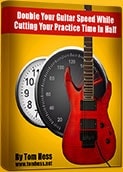


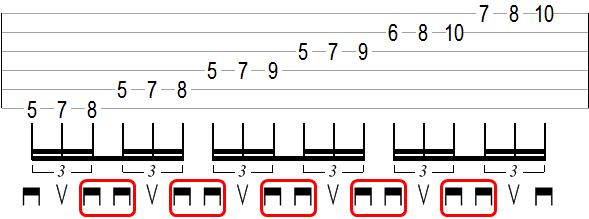

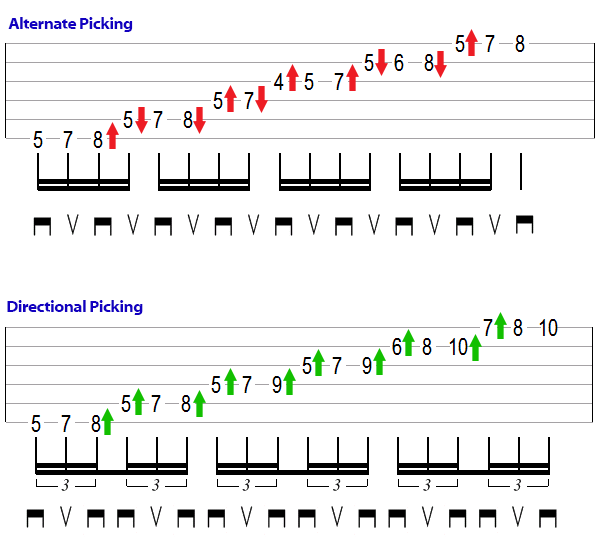
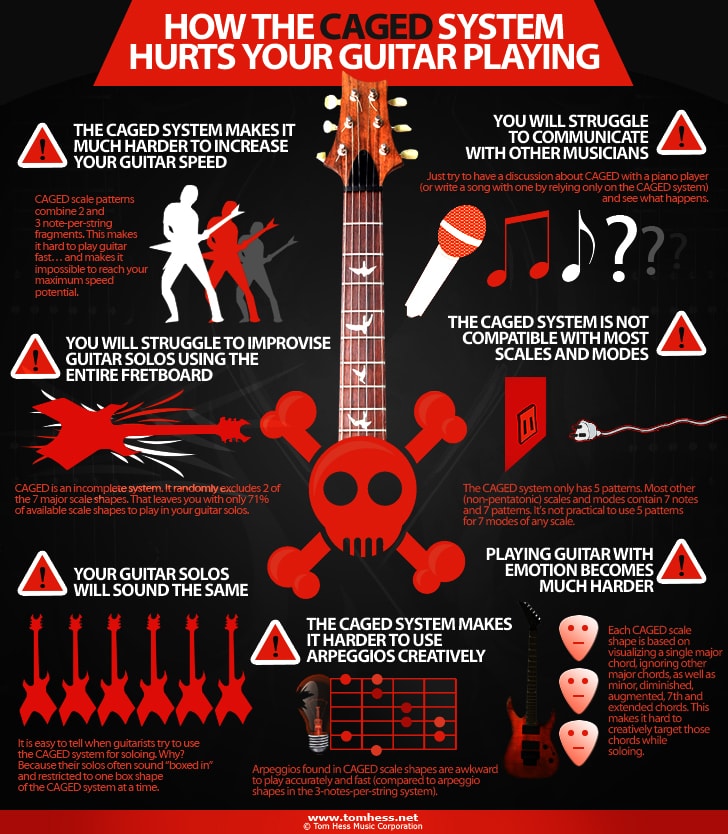
 How To Become A Great Guitarist
How To Become A Great Guitarist 10 Solutions For Musical Frustration
10 Solutions For Musical Frustration How To Reach Guitar Playing Goals
How To Reach Guitar Playing Goals